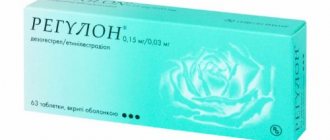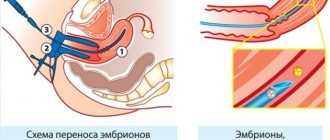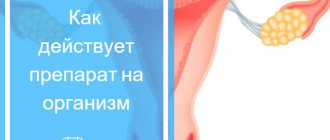Normal discharge
Immediately after cleaning the uterus, a woman begins to count down her new menstrual cycle. The first day is considered to be the day of manipulation itself. It is these menstrual flows that will be abundant for 2 days, since the vessels of the uterine cavity gape, turning it into a wound, and it will take some time for them to completely subside.
The first menstruation after curettage will begin approximately 21 days after the procedure and should not have any deviations.
If diagnostic curettage, hysteroscopy with curettage, cleansing for a missed abortion at short term, or abortion before 9 weeks of gestation are performed, then blood loss after the procedure should not exceed 150 ml, as with normal menstruation. The nature of the discharge immediately after gynecological intervention:
- the first 2 days are more abundant;
- no more than 4 pads are replaced per day;
- in one hour a woman uses no more than 2 pads;
- duration of bleeding is less than 7 days;
- clots may be released in the first 2 days.
2 days after the operation, the nature of menstruation will change - it will become less abundant, darker, and there will be no more clots. After 7 days there should be no period.
After curettage, very heavy periods with clots progress if:
- the reason for cleaning was pregnancy more than 12 weeks;
- in the past there has been chronic inflammation of the genital organs;
- fibroids (or several) in the thickness of the muscle layer;
- oncological pathology of the organ;
- endometriosis;
- impaired contractility of the uterus due to frequent pregnancies.
Woman action
The doctor is obliged to prescribe a painkiller so that the woman does not suffer from pain. To prevent infection and inflammation, the gynecologist prescribes antibiotics. If a woman suffers from uterine bleeding, oxytocin is injected. There are also recommendations that should be followed:
- Do not use tampons;
- Do not douche;
- Abstain from sex for an average of 14 days.
If a lady discovers alarming symptoms, inform her doctor.
Two weeks after cleaning the uterus, you need to come for an examination with a gynecologist.
Pregnancy planning can begin after a couple of weeks. If conception does not occur more than 9 months after curettage, it is worth visiting a doctor to determine the cause.
To summarize: an article is an article, but a woman should discuss all issues related to her health with a doctor.
Hysteroscopy
Hysteroscopy is a procedure for examining the uterine cavity in real time using optical instruments that transmit a magnified image onto a screen. This manipulation is diagnostic in nature and is prescribed for endometrial pathology, as well as in cases where examination of the uterine cavity can provide an answer to the diagnosis.
As a rule, hysteroscopy is accompanied by separate diagnostic curettage. Therefore, menstruation after hysteroscopy will have the same character as after regular cleaning. If the procedure is accompanied by ablation of the mucous layer, then vaginal discharge is not abundant or there will be none at all.
Reasons for heavy periods after curettage
A gynecologist will help you determine whether your periods are heavy after curettage, or whether they are going as they should. You cannot treat the problem yourself, as this will lead to complications.
A woman should be alert to the situation when there is no menstruation after cleansing - a sign of impaired outflow from the uterus.
After an abortion, miscarriage, frozen pregnancy and other pathologies, after curettage, the emptying of the uterine cavity is monitored. This is done using a manual gynecological examination and ultrasound of the uterus. An expansion of its cavity and an increase in size are revealed.
The main reasons for heavy periods after curettage:
- Hematometra is a condition in which the blood accumulated there and endometrial fragments are not removed from the uterine cavity. As a result, the uterus becomes overstretched and cannot contract normally. In addition, without proper drainage of fluid, infection occurs.
- Retention of the fertilized egg after a miscarriage or its incomplete removal is rare. A timely ultrasound will show the disorder.
- Endometritis is a condition when the layer of the mucous membrane becomes inflamed. Occurs due to existing infectious diseases of the genital area, individual insensitivity of the microflora to antibiotics, which are prescribed for prevention.
- Trauma to the genital tract occurs when the cervix dilates, curettage, or cauterization are performed.
- Hormonal imbalance. If a missed pregnancy, endometrial polyps, or dysfunctional uterine bleeding is caused by insufficiency of the hypothalamic-pituitary-ovarian-uterus system, then without normalization of the functioning of these endocrine organs, menstruation may be pathological.
- Insufficient contraction of the myometrium - hypotension - develops with high parity of pregnancy, scar changes after operations on the uterus, the presence of fibroids, endometriosis.
- A congenital or acquired bleeding disorder in a woman leads to heavy periods after curettage and other surgical interventions.
- Taking medications that prevent blood clotting - Aspirin, Warfarin, Xarelto and other anticoagulants.
First period after “cleaning”
All patients have a question: “after how many days do menstruation begin?” The first menstruation after curettage should normally be observed after 28-35 days. Conventionally, the day of the procedure is the first day of the menstrual cycle.
Usually, when everything went without complications, menstruation after curettage comes a month after the operation. They go as usual. The length of the days of menstruation remains unchanged.
Of course, it happens when menstruation is delayed after cleansing, but this is more a feature of the body. However, if the cycle does not return the next time or there is a delay that is accompanied by additional symptoms, this may be a sign of danger.
The first menstruation after curettage can be heavy or very scanty.
Much depends on the quality of the operation performed. If during the procedure the inner layer of the uterus was damaged, because of this the endometrium grows poorly, then after cleaning there are scanty periods. Light discharge may occur in women who have undergone a “cleansing” due to endometrial hyperplasia or polyp. After all, they are the cause of heavy bleeding. Scanty discharge is an indicator that the main goal of treatment has been achieved.
When heavy periods come after cleansing, especially if the procedure was performed specifically to prevent bleeding, this may indicate that there was hyperplasia, but not all of the endometrium was removed.
Cleaning after an abortion, miscarriage, or frozen pregnancy may be accompanied by the absence of menstruation for a month and a half. The woman’s body must adjust to new ovulation after the previous implantation. Plus, the first discharge may be more abundant. And if you don’t have your period after these days, you should seek medical help.
Within three months after surgery, painful red calendar days are possible.
What to do if you have heavy periods after cleansing
If a woman is bothered by discharge after curettage, then she should consult a doctor. According to indications, hemostatic therapy is performed:
- Sodium ethamsylate;
- Aminocaproic acid;
- Tranexamic acid;
- sex hormones;
- prostaglandin synthetase inhibitors;
- Oxytocin;
- Calcium gluconate;
- water pepper extract.
There is no need to try to stop bleeding from the genital tract at home. All drugs, with the exception of water pepper and Ascorutin, are available at the pharmacy with a prescription.
Under no circumstances should heat be applied to the lower abdomen after the curettage procedure!
Prevention of heavy bleeding
In order for the menstrual cycle to recover after surgery, it is important to follow the doctor’s recommendations and take the necessary medications:
- avoid physical activity;
- do not take a bath or visit the sauna for 2 weeks;
- no sex for 3 weeks;
- do not swim in ponds or pools;
- do not be in the open sun;
- eat well;
- use hormonal medications if necessary.
All this will allow you to quickly restore the uterine mucosa, normalize the menstrual cycle, and prevent heavy periods.
Curettage, or as popularly called cleaning of the uterine cavity, is carried out as prescribed by a doctor. He diagnoses a pathology or disease that can only be treated in this way. The process is to cleanse the uterus of eggs and endometrium. Why do heavy periods occur after curettage?
Menstruation after hysteroscopy
Heavy periods after curettage occur within a month. The report must be kept from the first day after the operation. Since normal menstruation lasts twenty-eight days, the approximate onset of the cycle is approximately three to four weeks.
There should be no changes in menstruation. The discharge should be red, without black clots. And if disturbances are observed, such as fever and pain in the lower abdomen, then you should immediately contact a gynecologist. But as a rule, the first cleaning does not cause complications.
Situations when you need to see a doctor
After the procedure, there may be some spotting for several days, lasting 3–7 days. If there is no discharge, a spasm of the cervix may have occurred and a hematometra is formed.
This assumption can be confirmed or refuted using ultrasound.
The following periods after curettage should force you to contact a gynecologist for help:
- Heavy bleeding. If you need to change the gasket every three hours, this means a serious problem that cannot be solved without the intervention of a specialist.
- Scanty menstruation after curettage, which is accompanied by dark blood and a stench.
- Increased body temperature, discomfort in the lower abdomen - this may indicate an inflammatory process within the body. There may be parts of a foreign body remaining.
- Unusual situations. For example, there is no menstruation for a long time, and then it flows like a tap.
- No bleeding. In this case, when there is no menstruation after cleansing even after 7 weeks, you need to sound the alarm and go to the doctor. Blood can collect inside the uterus, but due to spasm of the muscular lining of the cervix, it does not come out. Another possible reason for the absence of menstruation could be a “hormonal surge.”
- Pregnancy. After cleaning, the female reproductive system can recover in two weeks; perhaps the girl got pregnant. Therefore, if you don’t have your period, buy a pregnancy test and rule out this reason, or vice versa, treat yourself.
- Yellow discharge. No matter how many there are, this promises infection inside the uterine cavity. This requires a course of antibiotics.
Why are periods heavy after curettage?
In the first days after cleansing, there may be some bleeding. They should not be confused with menstruation, as they begin twenty-one days after curettage. And such periods after hysteroscopy with curettage are simply consequences of cleaning.
But if your periods after cleansing are heavy, then it’s worth thinking about, as they can carry news of the following diseases:
- hematometer;
- damage to the uterine mucosa;
- inflammation of the uterus;
- cervical rupture;
- remnants of the egg.
After heavy periods begin, you should consult a specialist to avoid diseases.
Hematometer
One of the diseases that occurs after cleaning the uterine cavity. A hematometra is an accumulation of blood that occurs after an unsuccessful evacuation. That is, it is frozen blood that cannot leave the uterus, which brings pain and discomfort.
Formed due to improper cleaning or abnormalities of the genital organs. But the uterus does not always close completely. Most often this is a spasm that prevents blood from leaving the body. It also forms during difficult and long labor. After them, a woman may even die.
Damage to the lining of the uterus
Damage to the uterine mucosa or, as it is called in medicine, endometritis. It occurs in women who have undergone surgery in the uterine cavity a large number of times. These are abortions, cleansing, miscarriage or treatment for another disease. The worst thing is that this disease is inflammatory in nature. Therefore, when it occurs, an increased body temperature may be observed.
- coli;
- streptococcus;
- chlamydia;
- gonococcus
These diseases can be contracted both in unsanitary conditions and from eating low-quality products.
But among the causes of damage to the uterine mucosa, there are more important ones, namely:
Probing of the uterine cavity is carried out in case of deviations in the structure of the uterus and suspected disease. It is performed in a hospital setting and in complete asepsis. If the rules of the operation are violated, then various diseases arise.
Inaccurate douching or too much of it provokes allergic reactions that are harmful to health and entail unpleasant consequences.
Both cleaning and hysteroscopy must be carried out according to clear rules. And deviations from sanitation or conduct standards lead to infection. That is, there is suppuration of the uterus. These consequences can only be removed by surgery.
Endometritis after curettage
Endometritis is a common occurrence after curettage. Appears due to inflammation of the lining of the uterus. And most often, inflammatory processes occur as a result of negligence and non-compliance with hygiene standards.
Discharge after scraping
For several days after curettage, bleeding may be observed, reminiscent of real menstruation. There's nothing wrong with that. But, if this situation drags on and, on top of everything else, the temperature is added, seek help from a doctor.
When, a few days after cleansing, the discharge turns brown and begins to clear up, this is a good sign. The blood began to clot and soon it would all be over.
Features of hysteroscopy
Like every procedure, this one has its own characteristics and nuances. In this case, a distinction is made between diagnostic and surgical hysteroscopy.
As for diagnostic hysteroscopy, this is just a visual examination of the uterine cavity; minor surgical interventions are performed. It is carried out in cases of suspected pathology and menstrual irregularities. And there are several features of this:
- use of anesthesia;
- the duration of the manipulation is no more than thirty minutes;
- After the procedure, the woman can go home without further hospitalization.
But surgical hysteroscopy has a number of difficulties when performing:
- stopping intrauterine bleeding;
- biopsy;
- use of general anesthesia.
After such an intervention, it is worth staying in the hospital for several days under the supervision of doctors.
Precautionary measures
After the operation, the woman is strictly prohibited from active sexual activity for three weeks, as well as any physical activity. You should avoid taking a very hot bath and generally increasing your body temperature through a sauna or bath. You also need to forget about douching.
If something bothers you, it is better to consult a specialist without self-medicating. And when restoring the menstrual cycle, it is strictly forbidden to use tampons, so as not to further damage the uterine cavity and cause irritation.
Only by adhering to these instructions can you continue your normal lifestyle and restore your menstrual cycle without complications or repeated operations.
Curettage is prescribed for girls of various age categories. After manipulation, menstrual flow will not look the same as before. Heavy periods after curettage can be both pathological and physiological. The cleaning procedure itself can cause a number of complications. You need to follow some recommendations in order to normalize your periods in a short time. The recovery period after the procedure takes several weeks. Any unpleasant symptoms require urgent medical attention. Otherwise, you may miss the development of serious complications.
Scraping is a serious procedure
What are the features of the curettage procedure?
The uterus is a muscular internal organ. The shape resembles a pear. This is where the fetus is normally formed. On the inside, part of the female body is protected by the endometrium, which is renewed monthly if fertilization does not occur.
The endometrium leaves the body during menstruation. There are two methods for performing curettage. Each method is briefly described in the table.
| Separate cleaning | The method is used most often. When carrying out such an intervention, the upper part of the mucous membrane is removed. The procedure is carried out using a special tool. The doctor sends the excised tissue for further diagnostics. |
| Conventional curettage | This procedure is carried out under the control of a hysteroscope. The doctor fully monitors the progress of the intervention. After this, the doctor will select the most suitable cleaning method. |
Curettage is always performed only when indicated. The patient is preliminarily prescribed a number of diagnostic measures that help establish the final diagnosis.
The essence of the procedure
A woman's uterus is a muscular organ that resembles a pear in appearance. The future baby develops in it. The inner wall is protected by a special membrane called the endometrium. Over the entire period of the monthly cycle, this shell must change.
Situations when conception of a child does not occur, the enlarged endometrium is rejected and comes out along with bloody discharge.
Curettage is the cleaning of the surface of the uterine wall. Nature dictates that after this procedure, the mucous layer of the endometrium is renewed independently.
Scraping is performed in two ways:
- Separately (RDV);
- Usually.
RDV is a fairly common procedure in gynecology. Its essence lies in taking the upper part of the inner wall of the uterus with special instruments. Selected internal tissues are necessarily sent for histological examination.
The usual curettage procedure is performed under hysteroscopy control. It is more popular because the doctor can see firsthand how the operation is performed using a hysteroscope.
Usually, curettage is carried out a few days before the expected menstruation, so the walls of the uterus are more likely to renew.
What are the indications for the procedure?
The procedure is usually carried out on the last or penultimate day of the menstrual cycle. There are two main reasons why cleaning is done:
- the need to eliminate existing tumors or a frozen fetus;
- the need to take a piece of tissue for further histological examination.
The procedure can be performed if there are formations in the uterus
Curettage may be prescribed if the following processes are detected:
- the presence of the remaining part of the placenta after delivery;
- polypous formations in the endometrium;
- the need to eliminate unwanted pregnancy;
- hyperplasia;
- miscarriage;
- uterine bleeding;
- adhesions that interfere with normal fertilization;
- disruptions of the menstrual cycle;
- endometritis;
- cancer of the cervix;
- adenomyosis.
It is worth immediately noting that curettage, even if indicated, is not a 100% safe procedure. After the procedure, the risk of complications increases. You must follow all the doctor's recommendations.
Indications for curettage
In medicine, uterine cleansing can be done for two reasons:
- In order to take the mucous layer of the membrane for additional research.
- And to remove pathological formations.
Reasons for doing the cleaning procedure:
- Endometrial polyps.
- Pathological growth of the endometrial layer – hyperplasia.
- Uterine bleeding of various origins.
- Disruptions in the menstrual cycle: heavy menstruation, too long period of bleeding, spotting between cycles.
- Inflammation of the uterus - endometritis.
- Adenomyosis.
- Adhesions in the uterus - synechiae, which interfere with conceiving a child.
- Pathology of the cervix, especially malignant.
- Miscarriage – the remaining placenta is removed.
- Frozen pregnancy – the dead fetus is removed.
- Abortion – the remains of the fertilized egg are removed.
- Cleaning after childbirth if part of the placenta remains.
What are the causes of heavy discharge
A few days or a week after the procedure, heavy discharge may appear. They should not be confused with normal menstruation. The symptom may indicate:
- hematometer;
- damage to the walls of the uterus;
- inflammation in the uterine cavity;
- cervical tear;
- the rest of the eggs.
Hematometra is one of the common diseases that is the result of curettage. In this case, there is a pathological accumulation of blood. The discharge cannot leave the female organs. The girl experiences severe pain and discomfort.
The disorder is the result of an incorrectly performed procedure or abnormal structure of the reproductive organs. Spasmodic sensations prevent blood from flowing out normally.
Endometritis is characterized by damage to the lining of the uterus. Typically, pathology is a consequence of frequent surgical interventions in the reproductive organs. These can be abortions, miscarriages, and curettages. The deviation is accompanied by an inflammatory process. The disease provokes an increase in body temperature.
Endrometritis can be accompanied by:
- coli;
- chlamydia;
- gonococcus.
Inflammation after scraping is a consequence of non-compliance with hygiene standards. Endometritis is accompanied by yellowish discharge. You need to see a doctor urgently. Otherwise, the risk of infertility increases.
Heavy bleeding is accompanied by cervical rupture. In this case, the patient needs surgical intervention.
After an unsuccessful abortive curettage, the fertilized egg may partially remain. In this case, the woman will experience heavy bleeding. If left untreated, anemia will occur. The girl loses consciousness. Body temperature rises. Death may occur.
Severe blood loss may cause fainting
Most often, the fertilized egg is partially retained during an abortion at a minimum period. High risk of infection.
What complications may there be?
Often the procedure becomes the root cause of complications. The reasons for the consequences include:
- too rough cleaning, in which the endometrium is not able to recover and partial or complete infertility occurs;
- damage by an instrument, in which menstruation may be absent for six months after surgery;
- improper use of an antiseptic or non-compliance with doctor’s recommendations, which lead to the formation of an inflammatory process;
- accumulation of blood in the uterus, which causes the penetration of an infectious process;
- cervical tears, which may require stitches.
Each patient after surgery should be prepared for the likely consequences. Complications occur quite often. If you experience any unpleasant symptoms, immediately seek help from a doctor.
Possible complications
Usually, after curettage, no complications are observed. Especially if the procedure was performed by an experienced and careful specialist, then after cleaning the uterus there are no unforeseen consequences.
The procedure involves removing the top layer of the uterine lining. And in women, the endometrial layer changes every cycle and then comes out along with menstrual discharge.
But still such situations happen:
- Damage to the uterus with an instrument during surgery . When the damage site is too large, the uterus is sutured. After uterine perforation, menstruation is restored within six months.
- The accumulation of blood inside the uterus significantly increases the chances of infection.
- Tears on the cervix. It happens that the forceps slip and tears form. Small injuries heal on their own, but large ones require stitches.
- Inflammatory processes in the uterus . The source is a violation of the rules for using an antiseptic; the doctor did not prescribe a course of antibiotics. Most often it manifests itself with high temperature. Treated with medications.
- Rough curettage , as a result, endometrial sprouts are damaged. Most often they are not restored and this threatens infertility.
How to normalize your periods
As a rule, the menstrual cycle is completely normalized after the first menstruation. In some cases, additional therapy is needed. Women are recommended to take:
- hormonal drugs;
- sedatives.
During the inflammatory process, patients are prescribed antibacterial medications to normalize the natural microflora of the body.
Additionally, vitamin and mineral complexes are recommended. There are also some recommendations. Doctors advise:
- observe basic personal hygiene;
- Healthy food;
- rest more;
- go for walks every day;
After the procedure, rest and walks in the fresh air are recommended.
- resort to moderate physical activity;
- give up any bad habits;
- adhere to the drinking regime;
- take all medications recommended by your doctor;
- Consult a doctor if there are any negative manifestations.
It is necessary to undergo an examination by a gynecologist for prevention. This will allow timely detection of possible complications.










